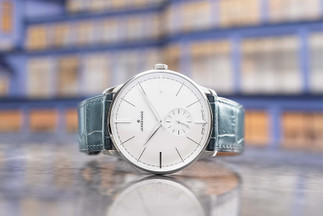Posted by Junghans Germany on 17th Feb 2021
An Architectural Masterpiece
Built on a sloping site, the terrace building is one of the most spectacular industrial buildings in the world, and symbolises one of the most outstanding periods in the history of Uhrenfabrik Junghans. This period which is now revisited in the form of two special timepieces limited to 1,500 units respectively: the Meister Classic Terrassenbau and the Meister Handaufzug Terrassenbau.
With an ever increasing demand for timepieces out of the Black Forest, Junghans counted as the biggest clock manufacturer in the world at the beginning of the 20th century. Due to the narrow nature of the valley in which the site of the business was located, Arthur Junghans and Stuttgart architect Philipp Jakob Manz took the decision to build the factory premises over nine levels on the steep hillside covered with a dense population of spruce. Over the following decades, the terrace building would become the core of watch and calibre assembly.
It was also during this period that the Meister models were born. The first mechanical watches in the series originated back as the 1930s, enjoying their heyday throughout the 1950s and 1960s. Automatic movements such as the chronometer calibre J83 developed specifically for the Meister series, are amongst the most sophisticated ever designed in the terrace building. The new Meister Terrassenbau series allows you to experience this particular period of the company’s history on your very own wrist. The classic elegance of the Meister models is represented in both limited special editions: A particularly intricate design, the convex dial with accentuated main indices and the harmonious aesthetics of the colour nuances are the achievement of masterly watch design.
The meandering pattern of the terrace building as an embossed design element is relayed in the minute track – standing out subtly in a soft grey from the fine matt silver of the dial. A white ring runs along the outer edge of the minute track to emphasize the elaborately crafted dial.
The hue of the alligator leather strap is taken directly from the dark green wall tiles which adorn the stairways of the architectural landmark. Applied using Junghans's very own printing facilities, a wonderfully detailed image of the source of inspiration itself is then revealed on the case back. The miniature transparent windows also provide a view of the inner workings: intricate interaction of numerous gear wheels with utmost precision, very much representative of the working procedures applied by the watchmakers of yesteryear.
Following extensive renovation work, the listed terrace building now houses a museum covering the history of clockmaking in the Black Forest. It also serves as a source of inspiration for the creation of exceptional timepieces more than one hundred years after its original construction – as so eloquently evidenced in the Meister Classic Terrassenbau and the Meister Handaufzug Terrassenbau.

